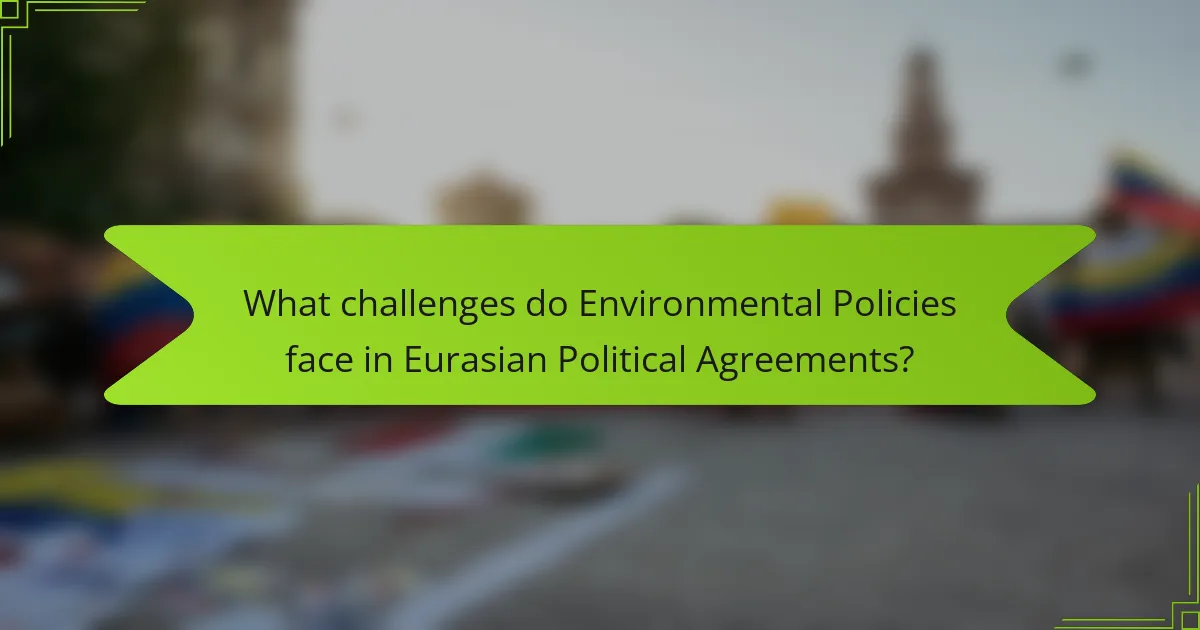Environmental policies in Eurasian political agreements serve as essential frameworks for member states to tackle environmental challenges collaboratively. These policies focus on sustainable development, carbon emission reduction, and biodiversity protection, facilitating regional cooperation on issues like pollution control and conservation. However, they face challenges such as inconsistent regulatory frameworks, economic priorities overshadowing environmental concerns, and political instability affecting implementation. Additionally, external pressures from global climate agreements complicate negotiations, creating a complex environment for effective policy execution. Overall, these policies reflect a collective commitment to ecological sustainability and resource management in the Eurasian region.

What are Environmental Policies in Eurasian Political Agreements?
Environmental policies in Eurasian political agreements are frameworks that guide member states in addressing environmental issues. These policies aim to promote sustainable development and ecological protection. They often include commitments to reduce carbon emissions and protect biodiversity. For instance, agreements may set targets for renewable energy use. Additionally, they facilitate cooperation on transboundary environmental challenges. Countries in Eurasia collaborate on initiatives such as pollution control and conservation efforts. The effectiveness of these policies is measured by progress in environmental indicators. Overall, they reflect a collective commitment to environmental stewardship among participating nations.
How do these policies impact the environment in Eurasia?
These policies significantly impact the environment in Eurasia by promoting sustainable practices and reducing pollution. They aim to enhance biodiversity conservation across various ecosystems. For instance, agreements often include commitments to reduce greenhouse gas emissions. The Paris Agreement, which many Eurasian countries are part of, sets binding targets for emissions reductions. These targets help mitigate climate change effects in the region. Additionally, policies encourage the use of renewable energy sources, decreasing reliance on fossil fuels. This shift leads to cleaner air and water quality. Furthermore, environmental regulations protect natural habitats from industrial development. Overall, these policies contribute to a healthier environment and sustainable development in Eurasia.
What specific environmental challenges are addressed by these policies?
These policies address air pollution, deforestation, and water scarcity. Air pollution challenges arise from industrial emissions and vehicle exhaust. Deforestation is driven by agricultural expansion and logging activities. Water scarcity affects regions due to over-extraction and climate change. These environmental challenges threaten biodiversity and human health. Effective policies aim to reduce emissions, promote sustainable forestry, and manage water resources efficiently.
How do these policies align with global environmental standards?
These policies align with global environmental standards by incorporating commitments to reduce greenhouse gas emissions. They also promote sustainable development practices that adhere to international agreements like the Paris Accord. Furthermore, the policies emphasize biodiversity conservation, which is a key element of the Convention on Biological Diversity. Compliance with these standards is often monitored through periodic assessments and reports submitted to international bodies. Data from these assessments show measurable progress in areas such as renewable energy adoption and waste management improvements. Additionally, collaboration with global environmental organizations helps ensure that these policies remain in line with evolving standards.
What are the key components of Environmental Policies in Eurasian Political Agreements?
Key components of environmental policies in Eurasian political agreements include sustainable development, biodiversity conservation, and climate change mitigation. These policies aim to balance economic growth with environmental protection. Sustainable development focuses on meeting present needs without compromising future generations. Biodiversity conservation involves protecting ecosystems and species from degradation. Climate change mitigation emphasizes reducing greenhouse gas emissions. Regional cooperation is essential for addressing transboundary environmental issues. International commitments, such as the Paris Agreement, guide these policies. Implementation mechanisms and monitoring frameworks ensure accountability and effectiveness.
What types of agreements are involved in these policies?
Environmental policies in Eurasian political agreements involve several types of agreements. These include bilateral agreements between two nations, multilateral agreements involving multiple countries, and regional agreements focused on specific geographic areas. Bilateral agreements often address specific environmental issues like pollution control or conservation efforts. Multilateral agreements, such as those under the United Nations framework, aim to tackle global environmental challenges collectively. Regional agreements may focus on transboundary issues, such as river management or air quality standards. These agreements are essential for fostering cooperation and ensuring environmental sustainability across the Eurasian region.
How are stakeholders engaged in the development of these policies?
Stakeholders are engaged in the development of environmental policies through consultations and collaborative frameworks. These processes often involve public forums, workshops, and stakeholder meetings. During these engagements, stakeholders provide input and feedback on policy proposals. Governments and organizations seek to incorporate diverse perspectives to enhance policy effectiveness. Research indicates that inclusive stakeholder engagement leads to better environmental outcomes. For instance, the UNEP emphasizes stakeholder involvement as crucial for successful policy implementation.

Why are Environmental Policies important in Eurasian Political Agreements?
Environmental policies are crucial in Eurasian political agreements because they address transboundary environmental issues. These policies facilitate cooperation among countries facing shared environmental challenges. They promote sustainable development and resource management across the region. Effective environmental policies can enhance regional stability by mitigating conflicts over resources. For instance, the 1992 Almaty Declaration emphasized regional collaboration on environmental protection. Furthermore, adherence to environmental standards can improve international relations and trade agreements. Countries that prioritize environmental policies often gain access to financial resources for sustainable projects. Thus, environmental policies play a key role in fostering collaboration and ensuring long-term ecological sustainability in Eurasia.
What role do these policies play in regional cooperation?
Environmental policies play a crucial role in regional cooperation among Eurasian countries. These policies facilitate collaboration on shared environmental challenges. They promote joint initiatives to address issues like climate change, pollution, and biodiversity loss. Regional cooperation through these policies encourages knowledge sharing and resource management. Countries can develop common standards and regulations to protect the environment. For instance, the Eurasian Economic Union emphasizes sustainable development through environmental agreements. Such policies can lead to improved diplomatic relations and economic benefits. Overall, they foster a collective approach to environmental stewardship in the region.
How do they foster sustainable development among member states?
They foster sustainable development among member states through collaborative policies and initiatives. These agreements promote environmental protection and resource management. Member states share best practices and technologies to enhance sustainability. They also engage in joint projects that address climate change impacts. Financial mechanisms support sustainable development efforts. Monitoring and reporting frameworks ensure accountability and progress tracking. Research and knowledge exchange enhance capacity-building among member states. These strategies collectively contribute to long-term sustainable development goals.
What are the implications for climate change mitigation?
Climate change mitigation has significant implications for global environmental policies. It necessitates international cooperation to reduce greenhouse gas emissions. Countries must commit to emission reduction targets under agreements like the Paris Accord. Transitioning to renewable energy sources is essential for effective mitigation. This shift can lead to economic benefits, including job creation in green industries. Implementing sustainable agricultural practices can enhance food security while reducing emissions. Climate adaptation strategies must also be integrated to address the impacts of climate change. Evidence shows that proactive mitigation can reduce future economic costs related to climate disasters.
How do these policies affect economic growth in Eurasia?
Environmental policies in Eurasia significantly impact economic growth. These policies aim to promote sustainable development and reduce environmental degradation. By implementing stricter regulations, governments can drive innovation in green technologies. This shift often leads to the creation of new industries and job opportunities. For example, investments in renewable energy have shown to boost local economies. Additionally, improved environmental standards can enhance public health, reducing healthcare costs. A healthier workforce is more productive, contributing positively to economic performance. Overall, while there may be initial costs, the long-term benefits of environmental policies can foster robust economic growth in the region.
Which sectors are most impacted by these environmental policies?
The sectors most impacted by environmental policies include energy, transportation, agriculture, and manufacturing. Energy sectors face regulations on emissions and renewable energy mandates. Transportation is influenced by policies promoting electric vehicles and fuel efficiency standards. Agriculture must adapt to sustainability practices and water usage regulations. Manufacturing sectors are affected by pollution control measures and resource efficiency requirements. These impacts are driven by the need to meet international environmental agreements, such as the Paris Agreement, which aims to reduce greenhouse gas emissions across various industries.
What are the economic benefits of implementing these policies?
Implementing environmental policies in Eurasian political agreements leads to significant economic benefits. These policies can enhance resource efficiency, reducing costs for businesses. They often promote innovation in green technologies, creating new market opportunities. Job creation in renewable energy sectors can result from such policies. Additionally, improved public health outcomes can lower healthcare costs, benefiting the economy. For instance, the European Union estimates that investing in sustainable practices could yield a return of up to €2 for every €1 spent. Such investments can lead to a more resilient economy, capable of adapting to climate change impacts.

What challenges do Environmental Policies face in Eurasian Political Agreements?
Environmental policies in Eurasian political agreements face several significant challenges. One major challenge is the lack of cohesive regulatory frameworks among member states. Each country has its own environmental standards and priorities, leading to inconsistencies. Additionally, economic interests often overshadow environmental concerns. Countries may prioritize industrial growth over sustainable practices.
Another challenge is the political will to enforce environmental policies. Political instability in some regions can hinder effective implementation. Furthermore, limited financial resources restrict the ability to invest in green technologies. Disparities in economic development create unequal responsibilities for environmental protection.
Lastly, external pressures, such as global climate change agreements, complicate negotiations. These pressures can conflict with national interests, leading to resistance in adopting stringent policies. Overall, these factors create a complex landscape for environmental policy implementation in Eurasian political agreements.
What are the barriers to effective implementation of these policies?
Barriers to effective implementation of environmental policies in Eurasian political agreements include lack of political will, insufficient funding, and inadequate regulatory frameworks. Political leaders may prioritize short-term economic gains over environmental sustainability. Funding limitations restrict the ability to carry out necessary projects and initiatives. Additionally, regulatory frameworks may lack clarity or enforcement mechanisms, hindering compliance. These factors collectively impede progress toward environmental goals. Studies show that countries with stronger political commitment and funding have better outcomes in policy implementation.
How do political differences among member states hinder progress?
Political differences among member states hinder progress by creating conflicting priorities and agendas. These differences can lead to disagreements on environmental policies and regulatory frameworks. For example, countries may prioritize economic growth over environmental protection. This can result in a lack of consensus on crucial initiatives. Additionally, member states may have varying levels of commitment to international agreements. This inconsistency complicates collaborative efforts to address environmental issues. Historical instances show that divergent political ideologies can stall negotiations. For instance, during the Paris Agreement discussions, disagreements among nations delayed actionable commitments. Consequently, political differences significantly impede progress in achieving unified environmental goals.
What are the funding challenges associated with these policies?
Funding challenges associated with environmental policies in Eurasian political agreements include limited financial resources and inconsistent governmental support. Many countries face budget constraints that hinder effective implementation. Additionally, reliance on international aid can create dependency and instability. The diversity of economic conditions among member states complicates funding allocations. Lack of transparency in financial reporting can lead to mismanagement and inefficiency. Furthermore, fluctuating political priorities may divert funds from environmental initiatives. These factors collectively undermine the sustainability and effectiveness of environmental policies in the region.
How can stakeholders overcome these challenges?
Stakeholders can overcome challenges in environmental policies by fostering collaboration and open communication. They should engage in regular dialogues to identify common goals. Establishing partnerships with local communities can enhance trust and cooperation. Stakeholders must also invest in capacity building to improve understanding of environmental issues. Utilizing data-driven decision-making can lead to more effective policy outcomes. Implementing adaptive management strategies allows for flexibility in addressing unforeseen challenges. Furthermore, stakeholders should advocate for transparent governance to ensure accountability. By employing these strategies, stakeholders can effectively navigate the complexities of environmental policies in Eurasian political agreements.
What best practices can be adopted for successful policy implementation?
Successful policy implementation requires clear communication of objectives. Stakeholders must understand the goals and processes involved. Engaging stakeholders early fosters collaboration and buy-in. Regular training ensures that all parties are equipped with necessary skills. Monitoring progress through measurable indicators is essential. Adjustments based on feedback can enhance effectiveness. Transparency in reporting builds trust among stakeholders. Research from the “Journal of Environmental Policy & Planning” indicates that these practices improve outcomes in policy adherence.
How can international collaboration enhance policy effectiveness?
International collaboration can enhance policy effectiveness by facilitating shared knowledge and resources. Collaborative efforts allow countries to pool expertise on environmental issues. This leads to more informed decision-making and innovative solutions. For example, joint research initiatives can yield comprehensive data on climate change impacts. These data-driven insights enable tailored policies that address specific regional challenges. Furthermore, collaboration fosters trust and commitment among nations. This can result in more robust enforcement of environmental agreements. Studies show that countries engaged in cooperative frameworks often achieve better environmental outcomes. Thus, international collaboration is crucial for effective environmental policy implementation.
What are the future trends for Environmental Policies in Eurasian Political Agreements?
Future trends for environmental policies in Eurasian political agreements include increased collaboration on climate change initiatives. Countries in the region are likely to prioritize sustainable development goals. This includes enhancing energy efficiency and transitioning to renewable energy sources. Additionally, there will be a focus on reducing greenhouse gas emissions. International agreements may lead to stricter regulations on pollution control. Countries may also invest in green technologies to boost their economies. Collaborative research on environmental issues is expected to grow. Enhanced monitoring and reporting mechanisms will likely be established to track progress on these policies.
How is technology shaping the future of these policies?
Technology is significantly shaping the future of environmental policies in Eurasian political agreements. Innovations in renewable energy sources are driving countries to adopt cleaner practices. For instance, advancements in solar and wind energy technologies are making them more cost-effective. Data analytics and monitoring technologies enhance environmental compliance and policy effectiveness. Satellite imagery allows for real-time tracking of deforestation and pollution levels. Furthermore, artificial intelligence is improving resource management and waste reduction strategies. The integration of these technologies is leading to more informed decision-making and stronger policy frameworks. As a result, countries are increasingly aligning their environmental policies with technological advancements.
What emerging issues should be considered in future agreements?
Emerging issues in future agreements should include climate change adaptation strategies. These strategies must address the increasing frequency of extreme weather events. Additionally, biodiversity loss must be considered in policy frameworks. Protecting ecosystems is crucial for long-term sustainability. Furthermore, water resource management is becoming increasingly critical. Competing demands for water can lead to conflicts among nations. Renewable energy transitions should also be prioritized in agreements. Shifting to sustainable energy sources is essential for reducing carbon footprints. Lastly, the impact of pollution on health and ecosystems must be integrated into discussions. Addressing air and water quality issues will enhance public health outcomes.
What practical steps can be taken to improve Environmental Policies in Eurasian Political Agreements?
Enhancing environmental policies in Eurasian political agreements requires several practical steps. First, establish clear environmental standards that member states must adhere to. This can include emissions targets and pollution control measures. Second, promote collaborative research initiatives focused on sustainable practices. These initiatives can help develop innovative solutions tailored to regional challenges. Third, implement regular assessments of environmental impacts related to political agreements. This ensures accountability and transparency among member states. Fourth, engage local communities in decision-making processes. Their insights can lead to more effective and culturally relevant policies. Fifth, secure funding for environmental projects through international cooperation and investment. This can facilitate the implementation of green technologies. Finally, foster education and awareness programs about environmental issues. These programs can inspire collective action towards sustainability.
Environmental policies in Eurasian political agreements serve as frameworks guiding member states in addressing ecological issues while promoting sustainable development. These policies focus on commitments to reduce carbon emissions, protect biodiversity, and facilitate cooperation on transboundary environmental challenges. Key components include climate change mitigation, sustainable resource management, and stakeholder engagement, with significant implications for regional cooperation and economic growth. Challenges such as political differences, funding limitations, and regulatory inconsistencies hinder effective implementation, while emerging trends indicate a shift towards enhanced collaboration and technological integration in future agreements.